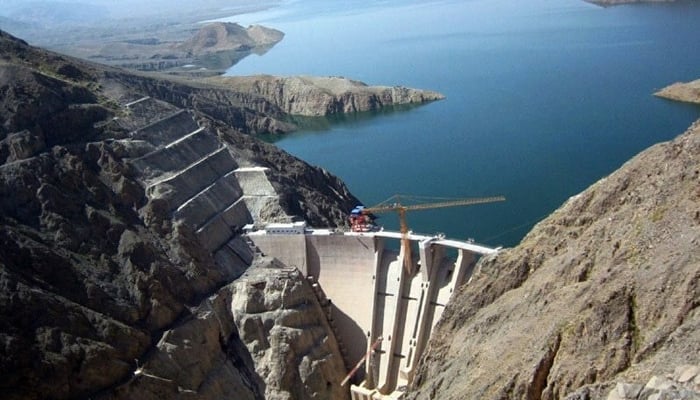India building 1,000MW hydropower project on Chenab
India has right to store 3.6m-acre-feet of water on Pakistan rivers for irrigation purposes
ISLAMABAD: India is erecting the first-ever hydropower project on Maru Sadar, the right bank tributary of Chenab River, with live dam storage of 99,000 acre-feet, having capacity to generate 1,000MW hydropower generation.
However, it is pretending that it will have live storage of 88,000 acre-feet with a faulty design of spillways in sheer violation of the Indus Waters Treaty (IWT) 1960, according to experts. The project will be completed within two years.
But Pakistan has already invoked Article 9 of the Treaty, under Paragraph 11 of Annexure-E, on the project’s spillways and free board designs way back one-and-a-half years ago. “We are observing the said project and already raised objections on its design under Article 9. We would again raise the issue under Article 9 of treaty with Indian side at PCIW level talks, which may be held before March 2024,” a senior official of PCIW (Pakistan Commissioner for Indus Waters) confirmed to The News.
India, under the Treaty, has the right to store 3.6 million-acre-feet of water on Pakistan rivers for irrigation purposes, and to this effect, it is going to complete the Pakal Dal project with a reservoir of 99,000 acre-feet of water.
Pakistan is of the view that India will have a live storage capacity of 99,000 acre-feet in the Pakal Dal dam and that the quantum of water should be deducted from 3.6 million-acre-feet of its water storage right.
But India, with a faulty design of spillways, wants to pretend since it has a live storage capacity of 88,000 acre-feet, so the volume of 88,000 acre-feet should be deducted from its right of water storage on Pakistan rivers.
If talks under Article 9 fail, the Pakistan side will start exhausting other endeavours mentioned in the Indus Waters Treaty, and after that in case no resolution is attained, Pakistan will be left with no option but to move a court of arbitration on the particular project.
Pakistan and India are currently fighting a legal battle in the topmost platforms of Neutral Expert (NE) and Court of Arbitration (CoA) at The Hague on faulty designs of 330MW Kishenganga erected on the Jehlum River and Ratle Hydropower project being constructed on the Chenab River.
Meanwhile, India has expedited its construction work for two more projects – the Kiru and Kwar projects upstream Ratle project on the Chenab River with designs that are in sheer breach of provisions of the Indus Waters Treaty 1960.
Pakistan has objected to the designs of Kiru hydropower project of 624MW and Kwar hydroelectric power project of 540MW in its recent interaction with India at the level of the Permanent Indus Waters Commission (PIWC). India is bound to share the designs of its projects with Pakistan under the Indus Waters Treaty.
The Kiru hydropower project is being built along the Chenab River near the villages of Patharnakki and Kiru, approximately 42 kms from Kishtwar. It will be located between Kirthai-II hydroelectric project to its upstream and the Kwar hydroelectric project to its downstream.
As per India, Kwar is a run-of-river project. The net head of the project will be 56.6 metres. The total number of penstocks, pipes or long channels that carry water down from the hydroelectric reservoir to the turbines inside the actual power station, is expected to be four in number. The penstock length will be 236 metres. The penstock diameter will be 5.65 metres. The project is expected to generate 1,975.54 GWh of electricity. The hydropower project consists of four turbines, each with 135MW nameplate capacity.
“India has shared with us some days back the designs of two more projects that it is planning to construct on the Chenab river upstream Ratle hydropower project,” a senior official of Pakistan’s Commission for Indus Waters told The News.
“We have submitted our objections on the designs of both the projects on components which include spillways, freeboard, and pondages. India is repeating the violations of design-related provisions of the Indus Waters Treaty 1960 in the designs of its projects despite Pakistan’s repeated objections. Similar faulty designs that have been adopted in the Kishenganga and Ratle projects are being repeated by India in more hydropower projects on Pakistan’s rivers,” the official added.
Transboundary water expert Engineer Arshad H. Abbasi said that a report recently published by the Ministry of Power India demonstrates the speed at which India is developing dams on the Chenab River. The progress report reveals the rate at which India is finishing the bumper-to-bumper projects along the Transboundary River.
Abbasi, while referring to the report, said India has finished the road construction work while the MAT (miscellaneous area tunnel) excavation was underway. Some 90pc of Power House Cavern’s excavation was finished, 15pc of the dam abutment excavation was accomplished, and 84pc of the Power House Access Tunnels excavation was finished. However, Indian environmentalists and local populace forced India to halt this project indefinitely.
The progress report states that 624MW Kiru HEP is anticipated to be finished in early 2024, after 16 months. The Kiru power project will only cost Indian Rupees (IR) 4.27 per unit, in contrast to the high tariff of Pakistani hydropower projects.
On another project, 540MW Kwar Hydropower Project on the same river, work is in full swing. This project will be completed in 2026 after three years. On completion, this project will offer electricity only at the rate of Indian Rupee 4.07 per unit.
-
 Philippines Blocks Elon Musk’s Grok AI
Philippines Blocks Elon Musk’s Grok AI -
 Jennifer Lawrence Blames Internet For Losing Sharon Tate Role
Jennifer Lawrence Blames Internet For Losing Sharon Tate Role -
 DeepMind, Google CEOs Sync Daily To Accelerate AI Race Against OpenAI
DeepMind, Google CEOs Sync Daily To Accelerate AI Race Against OpenAI -
 Japan Launches Probe Into 'Grok AI' Following Global Scrutiny Over 'inappropriate' Content
Japan Launches Probe Into 'Grok AI' Following Global Scrutiny Over 'inappropriate' Content -
 Prince Harry All Set To Return To Britain Next Week?
Prince Harry All Set To Return To Britain Next Week? -
 Is Princess Charlotte Becoming Most Confident Young Royal?
Is Princess Charlotte Becoming Most Confident Young Royal? -
 ‘Stranger Things’ Star David Harbour Speaks Up About ‘psychotherapy’
‘Stranger Things’ Star David Harbour Speaks Up About ‘psychotherapy’ -
 Jennifer Love Hewitt Talks About Scary 9-1-1 Episode
Jennifer Love Hewitt Talks About Scary 9-1-1 Episode -
 Kate Middleton Ditches Palace Life For Where She 'truly Relaxes'
Kate Middleton Ditches Palace Life For Where She 'truly Relaxes' -
 Pixel Watch May Soon Warn You If You Leave It Behind
Pixel Watch May Soon Warn You If You Leave It Behind -
 Serious Liver Scarring Shows Potential To Be Reversed With Latest Drug
Serious Liver Scarring Shows Potential To Be Reversed With Latest Drug -
 Elon Musk Backs Donald Trump To Invoke Insurrection Act Amid Minnesota Protests
Elon Musk Backs Donald Trump To Invoke Insurrection Act Amid Minnesota Protests -
 Scientists Unravel Mystery Of James Webb’s ‘little Red Dots’ In Deep Space
Scientists Unravel Mystery Of James Webb’s ‘little Red Dots’ In Deep Space -
 Nano Banana Explained: How Google’s AI Got Its Name
Nano Banana Explained: How Google’s AI Got Its Name -
 Fire Causes Power Outage On Tokyo Train Lines, Thousands Stranded As ‘operations Halted’
Fire Causes Power Outage On Tokyo Train Lines, Thousands Stranded As ‘operations Halted’ -
 YouTube, BBC To Ink Landmark Deal To Launch Exclusive Bespoke Shows
YouTube, BBC To Ink Landmark Deal To Launch Exclusive Bespoke Shows




